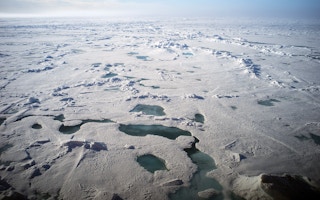Today is the fifth anniversary of the Paris Agreement. So, should we be popping open bottles of champagne? Not so fast…
To continue reading, subscribe to Eco‑Business.
There's something for everyone. We offer a range of subscription plans.
- Access our stories and receive our Insights Weekly newsletter with the free EB Member plan.
- Unlock unlimited access to our content and archive with EB Circle.
- Publish your content with EB Premium.
The world as a whole is still dangerously behind schedule in slowing down the catastrophic effects of climate change. However, nearly five years later, there are signs of positive changes happening, including from some of the world’s biggest polluters.
The “undercurrent” of the global economy has shifted, said Christiana Figueres, a former United Nations diplomat who led the negotiations that resulted in the Paris Agreement in 2015. “We are moving faster than we ever were,” she said at a press conference this week.
Since it’s Friday, and we’re closing in on Christmas, we have decided to focus on a glass that is half full and highlight the top 5 things the Paris Agreement has achieved in the past 5 years:
- Political resilience: Most of the world’s biggest emitters of planet-warming gases, including China, have promised to reduce their emissions to net-zero by the middle of the century.
- Normalising net-zero: Net-zero emissions is fast becoming a buzzword of 2020, with China, Japan and South Korea joining the European Union and the United Kingdom in setting carbon neutrality goals.
- Clean energy shift: Much more of the world’s electricity, which used to come almost entirely from burning toxic fossil fuels like coal, is coming from renewable sources, with the price of solar power falling far faster than expected.
- Institutional change: Institutions ranging from financial regulators to city authorities are embedding the deal’s targets and principles into their policies, creating new avenues for accountability.
- Normalising 1.5 degrees Celsius: One of the biggest surprises of Paris was the inclusion of 1.5ºC as an aspirational limit on global temperature rise. A key report, published in 2018 by the IPCC, reinforced the difference half a degree would make to millions of lives.
Onwards and upwards!
What Do We Say?
We thought the anniversary of the Paris Agreement would be the perfect time to analyse globally 1) how much companies are currently emitting and 2) check the implications for global temperature rise.
On the first point, our findings show that the proportion of companies disclosing at least scope 1 and scope 2 emissions rose from 44 per cent to 68 per cent, from 2014 to 2019. However, the rate of disclosure has not been consistent across regions. Europe leads the way with a disclosure rate of 51 per cent to 72 per cent. It’s interesting to note that Asia stole second place from the US in 2019. This is driven by both a decrease in disclosures from the USA and an increase in disclosures from Asia.
What does this mean for the rise in global temperatures? Our research shows that 45 per cent of European companies are aligned in the long term (2050) with the Paris Agreement, giving them an Arabesque S-Ray Temperature Score of 1.5ºC or 2ºC. In Asia and the US, these figures are 37 per cent and 33 per cent, respectively.
Furthermore, the USA has the highest proportion of companies receiving the 3ºC incomplete disclosure score (36 per cent), despite having the highest percentage of large companies that would typically fall under increased disclosure regulations. In comparison, 33 per cent of companies in Asia and 28 per cent of companies in Europe get the 3ºC score. This shows the scale of the challenge when we have missing information.
Increased transparency is vital to fill this data gap.
What does it mean?
It is important to recognise that significant developments have taken place in the past 5 years. But any sense of optimism about the progress driven by the Paris deal must be tempered by the harsh reality of how far there is to go.
A major United Nations report, published this week, found that greenhouse gas emissions continued to grow at an average of 1.4 per cent per year between 2010 and 2019. A far sharper rise took place in 2019, mainly due to emissions generated by wildfires, which are themselves exacerbated by a warming climate.
In 2020, emissions are expected to drop by about 7 per cent because of the economic slowdown caused by the coronavirus pandemic. But that would have what its authors called a “negligible” impact on the overall warming trend. The average global temperature has increased already by 1ºC since preindustrial times and is on course to rise by more than 3ºC by the end of the century.
So let’s keep working hard, and party even harder once more progress has been made.
Arabesque is a global group of financial technology companies offering sustainable investment, advisory, and data services through advanced ESG and AI capabilities.











